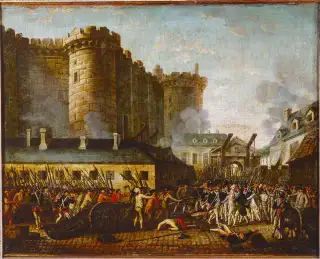Happy Bastille Day! The Hidden Investing Lessons of the French Revolution

It’s Bastille day—in other words, France's answer to the Fourth of July. The day commemorates the 1789 storming of the Bastille, a notorious prison fortress, and is for most of us in the U.S. just a good excuse to uncork a bottle of French wine. But there's also a famous story about the Bastille that contains a helpful lesson for investors.
Today, we think of 1789 as one of history's big turning points, but people had trouble comprehending that at the time. According to a famous anecdote, which may or may not be entirely true, King Louis, hearing news of the crowds at the Bastille, asked one of his advisers, “Is it a riot?” To which the adviser replied, “No, sire, it’s a revolution.”
The difficulty of deciding whether a surprise event is a temporary disturbance or something more profound isn't just a problem faced by kings. Investors have to deal with it, too. What it really comes down to is the subtle but crucial difference between risk and uncertainty.
For an example of risk, consider a typical bear market, defined as the stock market plunge of more than 20%. That's happened, on average, every 3.5 years in the past century. Bear markets are the stock-market equivalent of a riot (something that happened pretty frequently in Paris in the late 1700s). They're scary and confusing, and they can upset your plans.
But because bear markets are a relatively regular occurrence, even if you don't know precisely when the next one will hit, you should be able to prepare and ride most of them out.
But every once in a while, it turns out things are different. In 1789, for example, the soldiers who in the past had helped corral angry crowds turned their cannons around to face the castle fortress. That's uncertainty—the possibility that the patterns that held true in the past will cease to hold, and you'll find yourself in a new world with different rules.
For modern investors, the 2008-2009 financial crisis was a scary brush with uncertainty. The collapse of Lehman Brothers threatened to destroy economic confidence and snarl the operations of all kinds of businesses, crippling the broader economy. And the idea that you could get through bear markets just by buying and holding for long enough began to seem iffy. The ten years from 1999 through 2008 turned out to be a "lost decade" of negative returns for stocks.
Ultimately, the markets did come back. Though perhaps not soon enough for many people who retired just before the crisis, and who had to spend down their nest eggs much more quickly than they expected. And even for younger buy-and-hold investors, the 2008 experience was a reminder to take a look at a broader range of possibilities. There is no natural law that equities must always promptly climb back to previous levels; the Japanese stock market has never returned to its 1989 high.
Handling risk is mostly about planning and discipline—knowing what you can normally expect to lose and not letting your emotions get the better of you when those losses arrive. Dealing with uncertainty is less mathematically precise. It means having a back-up plan even when recent history suggests you probably won't need it. It's one very good reason to be broadly diversified, not just among U.S. assets, but with some foreign holdings, too. And it's a reason why most investors need to hold some assets in U.S. Treasury bonds, even though at today's low yields they don't seem very appealing.
Some market commentators will point out that right now those bonds look risky, since they'll register price declines when today's rock-bottom interest rates rise. That's true. But then remember, risk isn't the only thing you need to worry about. Treasuries are backed by the one payer no one seriously questions—the American taxpayer—and will pay their coupon and principal back when held to maturity. That's something few other investments can promise. And that's a hedge against uncertainty.